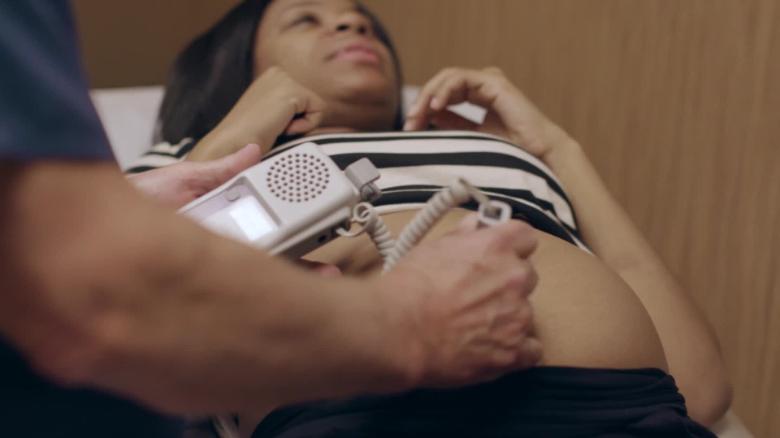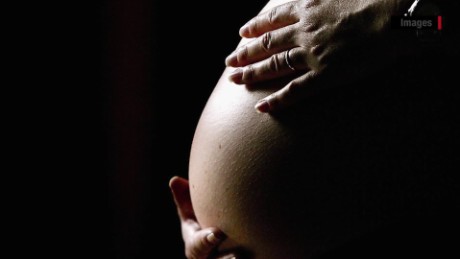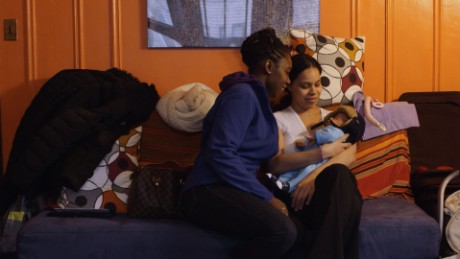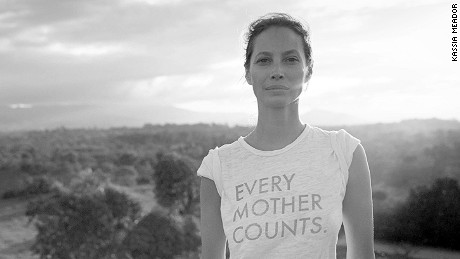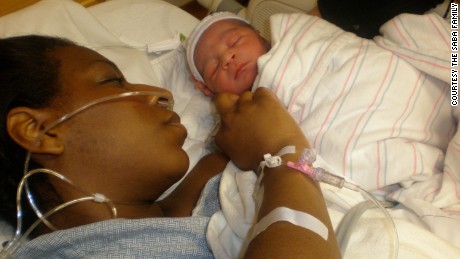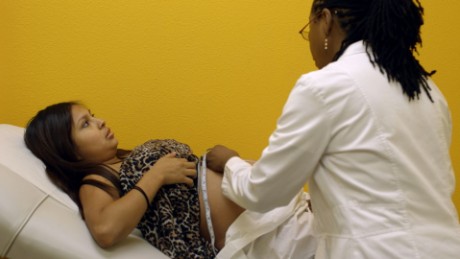Childbirth is killing black women in the US, and here's why
Updated 1335 GMT (2135 HKT) November 15, 2017
Story highlights
- Black women in US are three to four times more likely to die from pregnancy, delivery than white women
- Expert: Racial divide in maternal deaths has persisted for decades
The documentary series "Giving Birth in America" is produced by Every Mother Counts, a nonprofit organization that seeks to raise the profile and issues of maternal health in the United States.
(CNN)It was her second time lying numb in a hospital bed in North Bergen, New Jersey, with blood streaming down her legs and fear creeping into her heart.
At that moment, Timoria McQueen Saba thought to herself, "there's no way in the world that I'm the only woman who had this happen," she said.
In 2010, after giving birth vaginally to her oldest daughter, Gigi, one late afternoon in April, postpartum hemorrhage or excessive bleeding -- the leading cause of maternal death worldwide -- nearly killed her.
Then, about a year later, she started bleeding profusely in the small bathroom of a frozen yogurt shop. The blood was from a miscarriage, which left her feeling helpless in that hospital bed. She didn't know she was pregnant.
"I was all the way back to where I was the year before, and I realized ... I hadn't healed from the near-fatal traumatic experience the year before," said Saba, now the 39-year-old mother of two girls.
The former celebrity makeup artist, who saw clients such as novelists Candace Bushnell and Kyra Davis, decided to become a maternal health advocate, speaking on behalf of the 830 women who die from pregnancy- or childbirth-related complications every day around the world. That's about 303,000 a year.
Each year in the United States, about 700 to 1,200 women die from pregnancy or childbirth complications, and black women like Saba are about three to four times more likely to die of pregnancy or delivery complications than white women.
The quick-witted, savvy Saba said the data shocked her.
"It really took me a while to digest it," she said -- she survived something that many others around the world haven't.
"What was different about me? Why didn't I die? What were the reasons for that?" she asked. "I felt like I have a duty to tell this story, to represent my race in a way that not many people can, because I lived through it."
'We've known for a number of years'
Women in the United States are more likely to die from childbirth- or pregnancy-related causes than other women in the developed world, and half of those deaths may be preventable, according to the Centers for Disease Control and Prevention.
The CDC's pregnancy mortality surveillance system was implemented in 1986 to track maternal deaths. Since then, the number of reported pregnancy-related deaths nationwide steadily increased from 7.2 deaths per 100,000 live births in 1987 to 17.8 per 100,000 in 2009 and 2011.
Why the increase? Some researchers argue that health officials simply have improved counting deaths over time by using new classification codes and introducing a pregnancy status box on death certificates in 2003, which could make it appear that there's an increase.
Others argue that higher rates of obesity, women having children at older ages, and other social changes and trends in public health could drive an apparent increase.
Yet it remains complicated to answer why there has been a rise in deaths and why black women are more affected than women of other races, said Dr. Michael Lindsay, associate professor at the Emory University School of Medicine and chief of service for gynecology and obstetrics at Grady Memorial Hospital in Atlanta.
The racial divide in maternal deaths has been persistent for decades, Lindsay said, "so the rate is not something new. It's something we've known for a number of years."
Though maternal deaths are rare in the United States, many doctors and researchers have varying ideas about what factors could be driving this longstanding racial disparity in death rates.
Some point to the differences in overall health and chronic illnesses among black and white women as a driving factor for the disparity. For instance, rates of obesity and high blood pressure (or hypertension) -- risk factors for pregnancy complications -- tend to be higher among black women.
Others point to differences in socioeconomic status, access to health care, education, insurance coverage, housing, levels of stress and community health among black and white women, including even implicit bias and variations in the ways in which health care is delivered to black versus white women.
Historically, black women in low-income communities haven't had the same access to quality care as white women in high-income communities.
Those same factors shed light on disparities not only in maternal mortality but in obesity, hypertension, heart disease and overall health, said Dr. Elizabeth Howell, an obstetrician-gynecologist and professor at the Icahn School of Medicine at Mount Sinai.
"There are economics, social, environmental, biologic, genetic, behavioral and health care factors that all contribute to disparities in this country," Howell said.
"It's a complex web of these kinds of factors, and I think people are looking at and trying to figure out how these different factors actually all contribute to disparities," she said, adding that her research has focused on the factor of quality care.
For instance, Howell and her colleagues found that black women in New York City were more likely than white women to give birth in hospitals that already have a high rate of severe maternal morbidity or complications, according to a study published in the American Journal of Obstetrics and Gynecology last year.
The researchers found that 63% of white patients versus 23% of black patients gave birth in the safest hospitals in the study.
Solving a deadly problem
To examine differences in hospitals' quality of care, and to assess differences in how many black and white patients those hospitals cared for, the researchers analyzed hospital discharge and birth certificate data in New York City between 2011 and 2013, which was about 353,773 births.
"If we could narrow variation in outcomes and improve quality of care for pregnant women, we would reduce disparities," Howell said.
There have been efforts to establish standardized protocols, called patient safety bundles, across all hospitals -- whether they serve mostly white or black patients -- to appropriately assess and address childbirth complications, such as postpartum hemorrhage, with an equal quality of care, she said.
Health officials, doctors and advocates gathered Tuesday at the CDC in Atlanta to discuss efforts to measure and prevent maternal deaths and the racial disparities that persist. The public meeting included discussions of the effects that maternal deaths have on families and communities, as well as efforts to prevent deaths, such as those patient safety bundles.
As for establishing uniform bundles, "it addresses unequal treatment," said Dr. William Callaghan, chief of the CDC's Maternal and Infant Health Branch, who spoke at Tuesday's meeting.
"It's not a state-by-state solution to solving the problem of disparities. This is a national problem, and we all know it. It's always the elephant in the room in the United States that things are different," he said. "You'll find this across every health outcome."
Saba, who did not attend the meeting, was happy to hear that it was scheduled to take place, but she said she wished that actual patients had more of a presence on the agenda and more of a voice in the room.
"There are many advocates like myself. We have been sharing our stories for years or trying to. Yet we continue to be left out of most of these conversations," Saba said.
"There needs to be a better balance of speakers who can bring to light the full picture from legislation, research and statistics to real patients who survived a birth trauma or the families of those that didn't," she said.
Saba added that she has long been a proponent of the Preventing Maternal Deaths Act of 2017. The bipartisan bill was introduced in Congress in March to support state efforts to prevent maternal deaths, eliminate disparities in maternal health outcomes and identify solutions to improve health care quality for mothers.
It has not passed in the House or Senate.
'What could I leave for my daughter ... if I die?'
To this day, Saba remembers vividly the trauma she experienced while giving birth to her oldest daughter.
She still remembers seeing her reflection in the blank TV screen that overlooked her hospital bed during labor. In that reflection, she saw a river of blood pouring out of her body. Her blood pressure dropped, and her muscles felt weak.
"At that point, I'd never given birth before, and so I thought that was just a part of a birth. I didn't know any better," Saba said of the excessive bleeding.
"I'm watching the reflection in the television screen, and I can see that everybody in the room -- in terms of the health professionals -- their facial expressions had changed," she said.
That's when she knew something was wrong.
Saba's uterus was not contracting strongly enough to compress blood vessels after her delivery -- a condition called uterine atony -- and that led to the hemorrhage, she said.
"Many women do die of hemorrhaging, so that is a very common cause of maternal mortality and morbidity," said Dr. Mark Brescia, Saba's OB/GYN in New Jersey, who has been in practice for about 27 years.
As Saba was bleeding out, Brescia said, he and his team rushed to give her medication. That didn't help. He then massaged her uterus. That didn't help, either.
The bleeding "didn't respond to the normal treatment modalities we use," Brescia said. So Saba underwent a uterine-sparing procedure, he said, in which the blood vessels near her uterus were blocked without harming the uterus.
Saba said her surgeon told her she might not survive, and she immediately wished that she had time to write her daughter a letter.
"All I could think of was, what could I leave for my daughter to remember me by if I die?" Saba said. "I would have wanted her to know that she should never feel guilty about what happened, that it was not her fault."
The feeling of her 'body losing life'
After her postpartum hemorrhage, Saba said, she was diagnosed with post-traumatic stress disorder. She stayed awake at night with images of the blood flashing in her mind. She couldn't make them stop. She now knew the feeling┬Āof her "body losing life," she said, and she couldn't stop thinking about it.
"I would be up all night googling trauma, PTSD, hemorrhaging, and I couldn't find anything seven years ago that felt like something I could relate to," Saba said.
"So I would go on these PTSD chat rooms that war veterans were in, and I would tell my story, and they would take me in like I was one of their own," she said. "I found solace and comfort in the chat room of war veterans."
Eventually, after her miscarriage in that frozen yogurt shop, Saba started meeting with a therapist, she said. Saba ended up seeing a licensed clinical social worker who specializes in postpartum mental health and PTSD. Her PTSD symptoms were treated with a combination of therapy and restorative yoga.
As Saba reflected on all that she has overcome, she admitted that she often thinks back on that question: "Why didn't I die?"
"Looking at the statistics, I had excellent prenatal care. I had no preexisting conditions," Saba said, adding that she had "great" insurance.
"After realizing that this was not the norm, I decided to advocate for better ŌĆŗmaternal health care for all women," she said. "Low-income women, women of color, immigrant women are more likely to be uninsured. So not having access to maybe family planning services and all sorts of things can increase risk."
Even though many of those factors are out of women's control, there are some things that all moms-to-be can do to boost their chances of having a healthy pregnancy and delivery, Emory University's Lindsay said.
For instance, the World Health Organization issued a new series of recommendations last year to improve quality of prenatal care around the world. The recommendations include healthy eating and exercise, taking daily iron and folic acid supplements, and maintaining doctor appointments and ultrasounds during the course of the pregnancy.
A study published in the medical journal JAMA on Tuesday found that having a lower or higher body mass index than normal before pregnancy was associated with a small increase in maternal morbidity or mortality among women in Washington state.
The CDC's Callaghan said that planning for a baby and visiting a physician before there's a positive pregnancy test can make a difference.
"Check things out on the front end," he said. "What is my family history? What's my past medical history? What's my weight now? And begin to address those kinds of things prior to pregnancy."
If you are a smoker, stop, and if you have diabetes, control your blood sugar levels, Lindsay said. If you have a complication during pregnancy, such as high blood pressure or hemorrhage, following up with your doctor in the postpartum period is important.
"When we've gone back retrospectively and we've reviewed patients who've died, sometimes, there is a breakdown in some of those areas," Lindsay said. "After they've delivered the baby, they've sort of -- for lack of a better term -- fallen between the cracks."


